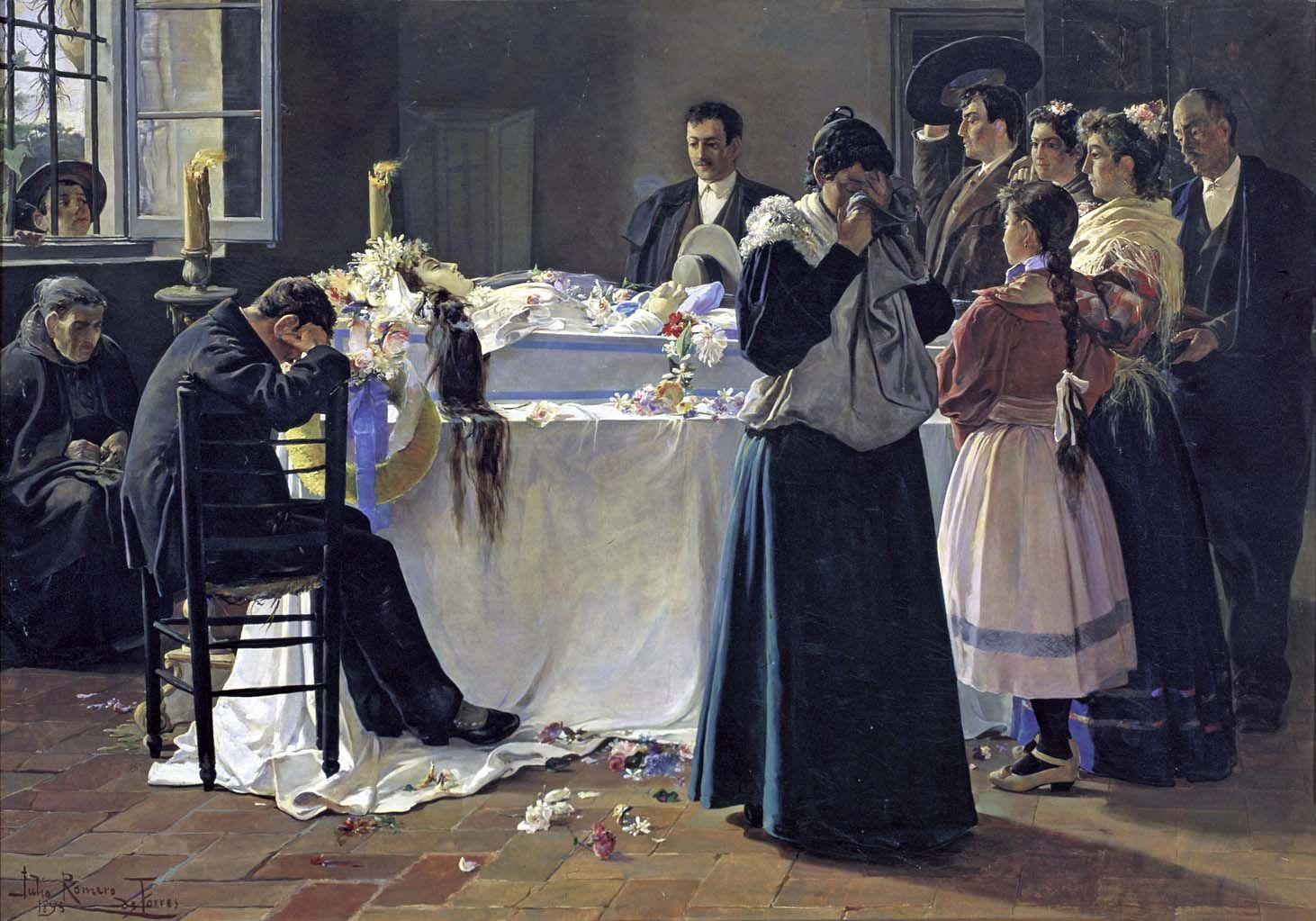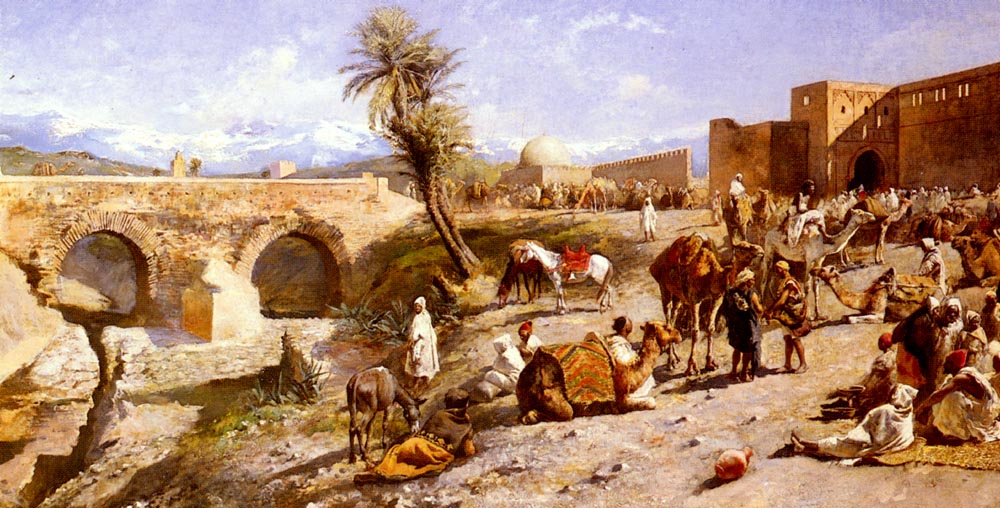|
Radonitza
Radonitsa (Russian Радоница, "Day of Rejoicing"), also spelled Radunitsa, Radonica, or Radunica, in the Russian Orthodox Church is a commemoration of the departed observed on the second Tuesday of Pascha (Easter) or, in some places (in south-west Russia), on the second Monday of Pascha. In Ukrainian tradition it is called Provody (Проводи). History and meaning The Slavs, like many ancient peoples, had a tradition of visiting family members' graves during the springtime and feasting together with them. After their conversion to Christianity, this custom transferred into the Russian Orthodox Church as the festival of ''Radonitsa'', the name of which comes from the Slavic word "radost'", meaning "joy." In Kievan Rus' the local name is "Krasnaya Gorka" (Красная горка, "Beautiful Hill"), and has the same meaning. In Serbia, the day is called "Pobusani ponedeonik" (Побусани понедеоник) i.e. "The Tomb-Sweeping Monday". The word "ponedeonik" ... [...More Info...] [...Related Items...] OR: [Wikipedia] [Google] [Baidu] |
Easter Egg
Easter eggs, also called Paschal eggs, are eggs that are decorated for the Christian feast of Easter, which celebrates the resurrection of Jesus. As such, Easter eggs are common during the season of Eastertide (Easter season). The oldest tradition, which continues to be used in Central and Eastern Europe, is to use dyed and painted chicken eggs. Although eggs, in general, were a traditional symbol of fertility and rebirth, in Christianity, for the celebration of Eastertide, Easter eggs symbolize the empty tomb of Jesus, from which Jesus was resurrected. In addition, one ancient tradition was the staining of Easter eggs with the colour red "in memory of the blood of Christ, shed as at that time of his crucifixion." This custom of the Easter egg, according to many sources, can be traced to early Christians of Mesopotamia, and from there it spread into Eastern Europe and Siberia through the Orthodox Churches, and later into Europe through the Catholic and Protestant Churche ... [...More Info...] [...Related Items...] OR: [Wikipedia] [Google] [Baidu] |
Wake (ceremony)
A wake is a social gathering associated with death, held before or after a funeral. Traditionally, a wake involves family and friends keeping watch over the body of the dead person, usually in the home of the deceased. Some wakes are held at a funeral home or another convenient location. The wake or the viewing of the body is a part of death rituals in many cultures. It allows one last interaction with the dead, providing a time for the living to express their thoughts and feelings with the deceased. It highlights the idea that the loss is borne by the whole community and is a way of honoring the deceased member. The emotional tone of a wake is sometimes seen as more positive than a funeral due to the socially supportive atmosphere and the focus on the life rather than the death of the deceased. __NOTOC__ Origin The term originally referred to a late-night prayer vigil but is now mostly used for the social interactions accompanying a funeral. While the modern usage of th ... [...More Info...] [...Related Items...] OR: [Wikipedia] [Google] [Baidu] |
John Chrysostom
John Chrysostom (; gr, Ἰωάννης ὁ Χρυσόστομος; 14 September 407) was an important Early Church Father who served as archbishop of Constantinople. He is known for his homilies, preaching and public speaking, his denunciation of abuse of authority by both ecclesiastical and political leaders, his ''Divine Liturgy of Saint John Chrysostom'', and his ascetic sensibilities. The epithet (''Chrysostomos'', anglicized as Chrysostom) means "golden-mouthed" in Greek and denotes his celebrated eloquence. Chrysostom was among the most prolific authors in the early Christian Church, although both Origen, Origen of Alexandria and Augustine of Hippo exceeded Chrysostom. He is honoured as a saint in the Oriental Orthodox Church, Oriental Orthodox, Eastern Orthodox Church, Eastern Orthodox, Catholic Church, Catholic, Anglican, and Lutheran churches, as well as in some others. The Eastern Orthodox, together with the Byzantine Rite, Byzantine Eastern Catholic Churches, Cat ... [...More Info...] [...Related Items...] OR: [Wikipedia] [Google] [Baidu] |
Holy Sepulchre
The Church of the Holy Sepulchre, hy, Սուրբ Հարության տաճար, la, Ecclesia Sancti Sepulchri, am, የቅዱስ መቃብር ቤተክርስቲያን, he, כנסיית הקבר, ar, كنيسة القيامة is a church in the Christian Quarter of the Old City of Jerusalem. According to traditions dating back to the 4th century, it contains the two holiest sites in Christianity: the site where Jesus was crucified, at a place known as Calvary or Golgotha, and Jesus's empty tomb, which is where he was buried and resurrected. Each time the church was rebuilt, some of the antiquities from the preceding structure were used in the newer renovation. The tomb itself is enclosed by a 19th-century shrine called the Aedicule. The Status Quo, an understanding between religious communities dating to 1757, applies to the site. Within the church proper are the last four stations of the Cross of the Via Dolorosa, representing the final episodes of the Passion of Jesus ... [...More Info...] [...Related Items...] OR: [Wikipedia] [Google] [Baidu] |
Ektenia
An ektenia (from el, ἐκτενής , translit=ektenés; literally, "diligence"), often called by the better known English word litany, consists of a series of petitions occurring in the Eastern Orthodox and Byzantine Catholic liturgies. The prevalent ecclesiastical word for this kind of litany in Greek is συναπτή ''synaptê'', while ''ektenia'' is the word preferred in Church Slavonic (ектенїѧ ''ekteniya''). A litany is normally intoned by a deacon, with the choir or people chanting the responses. As he concludes each petition, the deacon raises the end of his orarion and crosses himself; if there is no deacon serving, the petitions are intoned by a priest. During many litanies the priest says a prayer silently; when no deacon is serving, the response to the last petition is typically prolonged to give the priest time to finish the prayer. after the last petition of the litany, the priest says an ecphonesis which, when a silent prayer is said during the litany, ... [...More Info...] [...Related Items...] OR: [Wikipedia] [Google] [Baidu] |
Paschal Troparion
The Paschal troparion or ''Christos anesti'' (Greek: Χριστός ἀνέστη) is the characteristic troparion for the celebration of Pascha (Easter) in the Byzantine Rite. Like most troparia, it is a brief stanza often used as a refrain between the verses of a psalm, but is also used on its own. It is sung in the first plagal (or fifth) tone. Its author or date is unknown. Text The first line paraphrases from 1 Corinthians 15:20 (Νυνὶ δὲ Χριστὸς ἐγήγερται ἐκ νεκρῶν).Derek Krueger, "The transmission of liturgical joy in Byzantine hymns for Easter", in: Bitton-Ashkelony and Krueger (eds.) ''Prayer and Worship in Eastern Christianities, 5th to 11th Centuries'' (2016), p. 139 and note 41. The troparion is part of the Paschal Divine Liturgy of the Byzantine Rite, and it was certainly in use in the 5th or 6th century. Its ultimate origin is unknown; Metropolitan Hilarion (Alfeyev) (2009) has suggested a 2nd-century origin. Usage According to ... [...More Info...] [...Related Items...] OR: [Wikipedia] [Google] [Baidu] |
Crucession
A procession is an organized body of people walking in a formal or ceremonial manner. History Processions have in all peoples and at all times been a natural form of public celebration, as forming an orderly and impressive ceremony. Religious and triumphal processions are abundantly illustrated by ancient monuments, e.g. the religious processions of Egypt, those illustrated by the rock-carvings of Boghaz-Keui, the many representations of processions in Greek art, culminating in the great Panathenaic procession of the Parthenon Frieze, and Roman triumphal reliefs, such as those of the arch of Titus. Greco-Roman practice Processions played a prominent part in the great festivals of Greece, where they were always religious in character. The games were either opened or accompanied by more or less elaborate processions and sacrifices, while processions from the earliest times formed part of the worship of the old nature gods, as those connected with the cult of Dionysus and the Ph ... [...More Info...] [...Related Items...] OR: [Wikipedia] [Google] [Baidu] |
Incense
Incense is aromatic biotic material that releases fragrant smoke when burnt. The term is used for either the material or the aroma. Incense is used for aesthetic reasons, religious worship, aromatherapy, meditation, and ceremony. It may also be used as a simple deodorant or insect repellent. Incense is composed of aromatic plant materials, often combined with essential oils. The forms taken by incense differ with the underlying culture, and have changed with advances in technology and increasing number of uses. Incense can generally be separated into two main types: "indirect-burning" and "direct-burning". Indirect-burning incense (or "non-combustible incense") is not capable of burning on its own, and requires a separate heat source. Direct-burning incense (or "combustible incense") is lit directly by a flame and then fanned or blown out, leaving a glowing ember that smoulders and releases a smoky fragrance. Direct-burning incense is either a paste formed around a bamboo stic ... [...More Info...] [...Related Items...] OR: [Wikipedia] [Google] [Baidu] |
Divine Liturgy
Divine Liturgy ( grc-gre, Θεία Λειτουργία, Theia Leitourgia) or Holy Liturgy is the Eucharistic service of the Byzantine Rite, developed from the Antiochene Rite of Christian liturgy which is that of the Ecumenical Patriarchate of Constantinople. As such, it is used in the Eastern Orthodox, the Greek Catholic Churches, and the Ukrainian Lutheran Church. Although the same term is sometimes applied in English to the Eucharistic service of Armenian Christians, both of the Armenian Apostolic Church and of the Armenian Catholic Church, they use in their own language a term meaning "holy offering" or "holy sacrifice". Other churches also treat "Divine Liturgy" simply as one of many names that can be used, but it is not their normal term. The Greek Catholic and Orthodox Churches see the Divine Liturgy as transcending time and the world. All believers are seen as united in worship in the Kingdom of God along with the departed saints and the angels of heaven. Everything in ... [...More Info...] [...Related Items...] OR: [Wikipedia] [Google] [Baidu] |
Matins
Matins (also Mattins) is a canonical hour in Christian liturgy, originally sung during the darkness of early morning. The earliest use of the term was in reference to the canonical hour, also called the vigil, which was originally celebrated by monks from about two hours after midnight to, at latest, the dawn, the time for the canonical hour of lauds (a practice still followed in certain orders). It was divided into two or (on Sundays) three nocturns. Outside of monasteries, it was generally recited at other times of the day, often in conjunction with lauds. In the Byzantine Rite these vigils correspond to the aggregate comprising the midnight office, orthros, and the first hour. Lutherans preserve recognizably traditional matins distinct from morning prayer, but "matins" is sometimes used in other Protestant denominations to describe any morning service. In the Anglican daily office, the hour of matins (also spelled mattins) is a simplification of matins and lauds from th ... [...More Info...] [...Related Items...] OR: [Wikipedia] [Google] [Baidu] |
Vespers
Vespers is a service of evening prayer, one of the canonical hours in Eastern Orthodox, Oriental Orthodox, Catholic Church, Catholic (both Latin liturgical rites, Latin and Eastern Catholic Churches, Eastern), Lutheranism, Lutheran, and Anglican liturgies. The word for this fixed prayer times, fixed prayer time comes from the Latin , meaning "evening". Vespers typically follows a set order that focuses on the performance of psalms and other biblical canticles. Eastern Orthodox services advertised as 'vespers' often conclude with compline, especially the all-night vigil. Performing these services together without break was also a common practice in medieval Europe, especially secular churches and cathedrals. Old English speakers translated the Latin word as , which became evensong in modern English. The term is now usually applied to the Anglican variant of the service that combines vespers with compline, following the conception of early sixteenth-century worshippers that conce ... [...More Info...] [...Related Items...] OR: [Wikipedia] [Google] [Baidu] |







